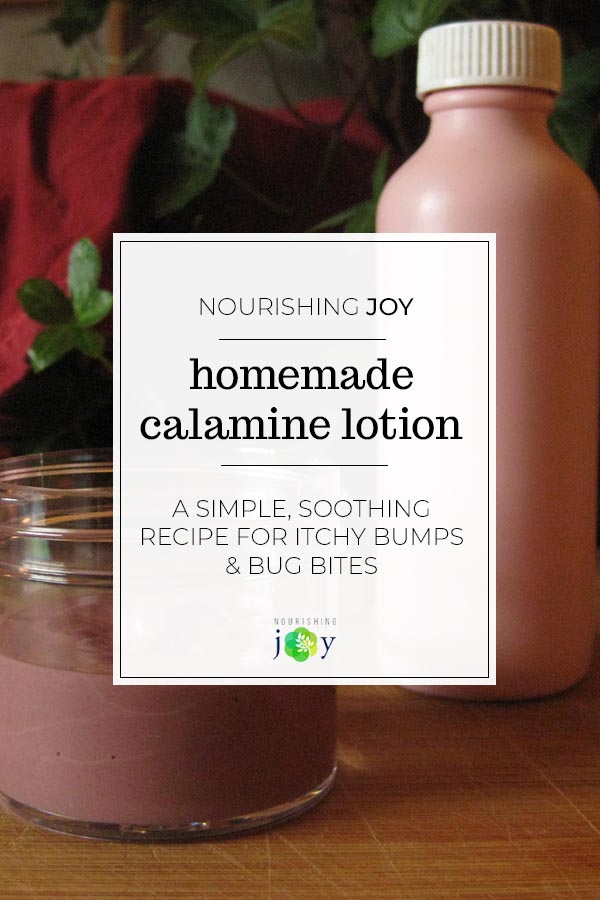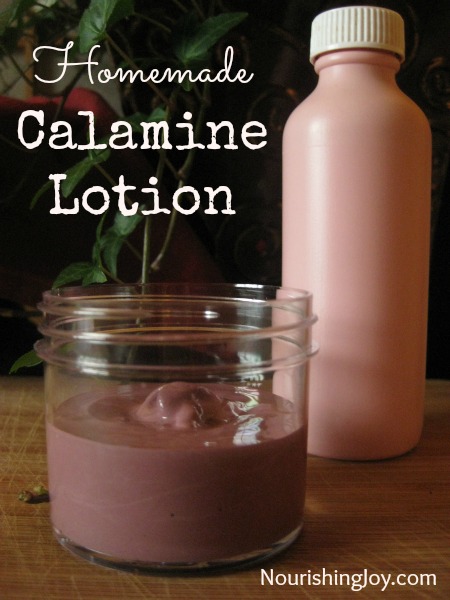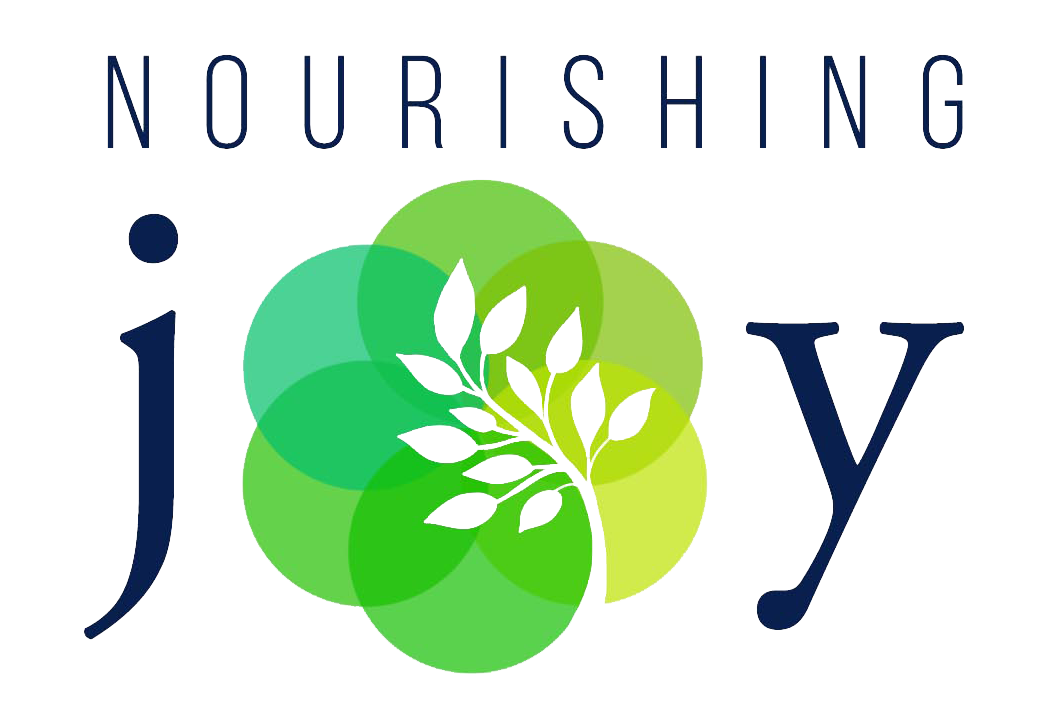Homemade Calamine Lotion
This post may contain affiliate links, including those from Amazon.com, which means we earn a small commission off your purchases. And here's the thing: We only mention services and products that we think are truly worth your attention, whether they're free, paid, or otherwise. This site relies on YOUR trust, so if we don't stand behind a product 110%, it's not mentioned. Period.



A couple of weeks ago, my daughter suddenly and mysteriously broke out in hives.
So, of course, the first thing I did was to go to our Facebook page and asked for the sage advice of all the mamas there. (Thank you, mamas!)
And secondly, I reached for the bottle of calamine lotion that's always waiting in the back of the first aid closet.
Except that it was nearly empty…. now what?
I did what I usually do. I reverse engineered it. I flipped the bottle over, read the ingredients, realized that we had the majority of items required on our “homemade lotions and potions” shelf, and whipped up a batch in less than 3 minutes.
Now, I ended up concocting two different recipes. They're very similar, so use choose one according to what ingredients are easiest for you to procure.
For great step-by-step photos, check out the post Everyday Roots put up when they tried our recipe. Their photos are really helpful!
Homemade Calamine Lotion
N.B. Since these ingredients may be hard to find for some – and because I get lots of e-mails asking for recommendations – I've linked each difficult-to-find ingredient to online sources of brands I use. These are affiliate links, but they are most definitely products I use myself. I hope that makes it easier for everyone to make this simple homemade calamine lotion!
Recipe #1
1/4 cup zinc oxide
1/2 teaspoon iron oxide – I also use this in homemade crayons
4 teaspoons bentonite clay
4 teaspoons baking soda or 2 teaspoons calcium hydroxide (“cal” can also be found in Latino groceries)
1/4 cup water
1/2 teaspoon glycerin (optional)
3-4 drops lavender essential oil or other antibacterial essential oil (optional)
Recipe #2
1/4 cup zinc oxide
4 teaspoons pink Kaolin clay
4 teaspoons baking soda or 2 teaspoons calcium hydroxide
1/4 cup water
1/2 teaspoon glycerin (optional)
3-4 drops lavender, peppermint, camphor, tea tree, or other antibacterial/antipuretic essential oil (optional)
Method:
Combine all ingredients in a small bowl and whisk until smooth. Store in the refrigerator for 1-2 weeks.
If you'd like to store it for longer than that, here's an idea: Whisk together all powdered dry ingredients and store in a bottle or jar. When needed, place only as much as you need into a bowl and add water, glycerin, and essential oils. This way it's fresh and effective!



The Ingredients
Zinc Oxide: Zinc oxide been used for centuries as a skin protectant and ointment, with references in medical literature showing up in India as early as 500 BC and in Greece in the first century AD. ((The History of Zinc Oxide – Wikipedia)) It is helpful in the treatment of skin wounds and traumas and doesn't absorb into the skin, which allows it to be an effective topical treatment and promotes healing.
Iron Oxide: This is what gives calamine its characteristic pink color. The mixture known as “calamine” is a mixture of zinc oxide and about 0.5% iron oxide. ((The Chemical Composition of Calamine – ScienceLab.com)) We're using more than that small amount in this recipe to make it easy, and it's mainly here as a colorant rather for its medicinal properties.
Bentonite Clay: Bentonite clay is typically used for internal detoxification, but because commercial preparations of calamine use bentonite, I used it too. However, the pink kaolin clay I happened to find at my local soapmaking supply store actually produced a better color AND kaolin clay is more commonly used in topical cosmetic preparations because of its very gentle detoxification on the skin, so even though it's not an exact reverse engineering of the store-bought stuff, I'd recommend the kaolin clay. ((Mountain Rose Herbs – Clay: The Medicinal and Cosmetic Benefits))
Baking Soda: Baking soda is wonderful as an anti-itching agent, it's cheap and plentiful, and it's typically in every kitchen, making it an important part of this recipe. In store-bought calamine lotion, calcium hydroxide is what performs this function, but baking soda is definitely more common. If you'd like to try the calcium hydroxide, you can find it at Latin grocery stores under the name “cal” or “slaked lime,” as it's used in the process of grinding corn for tortillas.
Glycerin: Glycerin is used in cosmetic applications as a skin protectant and a moisturizer. Even in the small amount used here, it makes the homemade calamine lotion a bit smoother and softer. It's definitely optional, so if you don't have it, don't worry about it.
Essential Oils: Essential oils are included here both for the scent and the healing properties. Be sure to use the highest quality you can afford since this will be applied directly to the skin. Lavender, peppermint, camphor, and tea tree oil are all known for their ability to relieve itching, so those are certainly some of the most popular, but consult a knowledgeable aromatherapist if you want to get creative with your oils, as there are certainly others that would be helpful.
Where to Find Ingredients for Homemade Calamine Lotion
I've gotten questions about where to find the ingredients for making homemade calamine lotion, so here's where I tend to source mine:
Most of these ingredients can be found at your local health food store, including the bentonite clay.
Iron oxide and kaolin clay can be found at any soapmaking supply store (iron oxide is typically used for tinting homemade cosmetics like blush and bronzer).
The zinc oxide I pick up for a dollar or two at my local compounding pharmacy – I just have to ask for it specifically. I've also seen it at soap and candle making supply stores.
And calcium hydroxide can be found at Latin grocery stores or at World Market / Cost Plus under the name “cal” or “slaked lime.” Two of my local grocery stores even carry it – one stocks it in the spice aisle and one stocks it with the ethnic foods.





You were out of calamine but had all that other stuff? Impressive! Also, do you have a cost breakdown? Is there an advantage healthwise or $wise in making your own? Thanks!
I know it sounds far out to have clay and zinc oxide on hand, but they really are easy to find and very common ingredients in homemade cosmetics and personal care. 🙂 Also bentonite clay is a wonderful heavy-metal binder and detoxifier, so since I discovered it’s easy to find at our local health food store, I tend to keep it on hand to eat when we have mercury-heavy fish. 🙂
The only advantages health-wise would be avoiding whatever preservatives the store-bought stuff has and have a fresh preparation, which should make it as effective as possible. In the brand I have, that preservative is imidurea, an anti-microbial agent that’s common in cosmetics. It doesn’t exist in the Environmental Working Group’s SkinDeep Cosmetic Database, so I have no idea of its safety. It might be totally innocuous for all I know! 🙂
As for cost breakdown, here’s an estimation of costs:
1/4 cup zinc oxide ~ $1.12
(1/4 cup~28 grams / 58 gram (2 oz) bag = $2.25)
1/2 teaspoon iron oxide ~ $0.27
(1/2 teaspoon~2 grams / 28 gram (1 oz) bag = $3.75)
4 teaspoons bentonite clay ~ $0.42
(4 teaspoons~12 grams / 283 gram (10 oz) container = $9.99)
4 teaspoons pink kaolin clay – $0.74
(4 teaspoons~15 grams / 58 gram (2 oz) bag = $2.95)
4 teaspoons baking soda ~ $0.04
(4 teaspoons~20 grams / 500 gram (1.1 lb) box = $1.00)
1/2 teaspoon glycerin (optional) ~ $0.19
(1/2 teaspoon~4 mL / 120ml bottle = $5.59)
3-4 drops lavender essential oil ~ price will vary greatly – mine worked out to ~$0.15
Water
(1/4 cup~63 grams)
Thus:
Recipe #1 ~ $2.19 for 129 grams (measures out to ~140 mL)
Recipe #2 ~ $2.24 for 130 grams (measures out to ~140 mL)
For reference, my no-name brand cost $4.49 for 115 mL.
If you want to make the recipe even more cheaply, you can leave out the iron oxide, glycerin, and essential oils and still have an effective anti-itch lotion.
I hope that helps!
Someone would say the same thing about me…I enjoy a ayurvedic lifestyle so I too would have most of those ingredients.
My favorite is bentonite clay or rhassoul clay. They are great for making a mask for your hair or face.
Thanks for the recipe.
I love that you give these recipes out i will probably never make it but it is neat to know i could
PLEASE! Do proper research before passing on DANGEROUS MISINFORMATION. Calcium HYDROXIDE is CaOH — a highly-caustic chemical which can cause BURNS to the skin. «CAL» is NOT the hydroxide but Calcium (Bi-) Carbonate, which although more alkaline than the benign Sodium Bicarbonate mentioned has a higher pH and thus should be used with caution.
Um, no. You are correct in that it is caustic and can cause chemical burns if used alone in its pure form, but calcium hydroxide is very widely used throughout the food and cosmetics industries, despite its caustic nature. Even Wikipedia has a rundown on it that’s decent – https://en.wikipedia.org/wiki/Calcium_hydroxide
And you are incorrect in that the *cal* to which I am referring is calcium carbonate – I am indeed referring to calcium hydroxide, the same that is used for making tortillas and infant formula and pickles.
Zinc Oxide:
Iron Oxide:
Bentonite Clay:
kaolin aka as EPK
I am a potter. i make my own pottery glaze so I have all of this in my studio.
thanks for the information! Love your page!
I have some Bentonite that is brownish ? From closed out Pottery shop .
Not Gray ?
cannot find much on it ?
This is great! My sister is allergic to normal calamine lotion. Using this, she may be able to pinpoint the exact ingredient that bothers her and leave that part out! Will be great for her. Thanks <3
This is one recipe that is not worth the trouble to find the ingredients. I’ll buy the $1.98 Walgreen’s calamine, nothing so toxic in that. I have used herbs, essentials, teas, alternatives for 30 years and extoll the benefits of doing such. Just not for this.
Definitely a valid point. If you can find the ingredients at a good price, it’s just satisfying knowing that it’s possible. 🙂
Do you think plain white kaolin clay would have the same benefits as the pink? (White is what I have on hand.) From what I’ve read the pink color is mostly from iron oxide’s influence, but I haven’t found much information on the difference for cosmetic use.
Yes, absolutely, use the white. From what I’ve read, the iron oxide has a bit of a benefit, but largely it’s the clay that is needed, so definitely use what you’ve got. 🙂
Im always trying to make my own face creams. Ive been using bees wax concoctions but my latest idea is not to stress over making a cream but having a liquid emulsion. So I combined grape seed oil and baobab oil and rose water with calamine lotion and the effect is great because one is applying a healthy dose of oil to the skin but it dries matt. I also add essential oils to the mixture. It also seems to cover up flaws in the skin so Im not using base anymore. thats why I was checking on the content of calamine. It sounds like I could be onto something…….
My locale IDA drug store ordered in tjhe zinc oxide for me when I was making sunscreen. They’d probably be able to get the iron oxide too.
Hi,
Thank you for sharing. Just a very practical question. when you say 3-4 drops of EO…is that in total or 3-4 drops of each EO?
Happy holidays!
That’s 3-4 drops total if you’re using multiple essential oils. 🙂
Woke up in the middle of the night sans calamine but with a very itchy baby. I google homemade calamine recipe and who should pop up at the top of the list but my dear friend. Unfortunately in my young supply cabinet I am missing a couple of things. But not for long 🙂 Thanks Kresha. Off for another oatmeal bath.
Tami! How lovely to hear from you!!! I do hope your sweet babe will be itch-free very soon. 🙂 And I wish you a very happy and blessed new year!
I LOVE the color of this calamine lotion recipe. I would love to use this color (diluted of course) for a body lotion recipe I am working on and was wondering if you could tell me what color Iron Oxide this is and where to purchase it. I understand if that is proprietary information, but if not I would love to know!
No worries! There are two batches shown in these pictures. For one batch (the one that’s darker in the pictures) I used Burgundy Iron Oxide and for the other (the one that’s more like conventional calamine lotion) I didn’t use any iron oxide but I used pink Kaolin clay.
I hope that helps! 🙂
Thanks 🙂
Oh – I misspoke! Both of these photos show the same batch – they’re the ones using the Burgundy Iron Oxide. 🙂
I am curious why there is no warning about handling the zinc oxide while making preparations. I have read that you should avoid breathing zinc oxide in at all costs, as it can ruin a persons sense of smell, and though it is GRAS on skin, and has a low incidence of allergic reactions, I would suggest wearing a mask while working with it.
Yes, care to avoid inhalation is needed while working with any powder, especially ones that include metallic minerals! Thanks for the good reminder. 🙂
Hi! Could I substitute ACV for the water and make the lotion last longer?
Hmm… that’s an interesting idea! My immediate thought is that yes, that would help extended the shelf life by a few weeks AND it could be beneficial for certain types of wounds (burns, bug bites, etc). However, remember than if you dip your fingers in it at any point, you’ve added bacteria and even vinegar won’t keep it fresh forever.
But it’s a great idea! Go for it!
The link for the iron oxide isn’t working. Can you do another please? Thanks!
I’ve updated the link! Sorry about that. I’m sorry the previous one is no longer available…. 🙁
This looks so good! What a great natural remedy to have on hand!
Thanks for sharing! Can I freeze it?
What’s the shelf life?
As the method for both recipes states (and as is true with any recipe that includes water without preservatives), the homemade calamine lotion should be used within 1-2 weeks.
If you follow the directions to be able to store the mixture longer and combine all the dry ingredients without adding water, the mixture will last for several years.
I hope that helps! 🙂
I was just scrolling through and this caught my attention. Being a mother as well I’m always searching for healthier ways to care for my children and one that is more natural. Thank you for sharing this helpful information.
I need to keep this recipe handy.
But where is the calamine? No doubt this is soothing, but it does not have any calamine in it?
This IS calamine. Calamine is a mineral powder blend of zinc oxide and ferric oxide (iron oxide), which is what makes it pink. 🙂